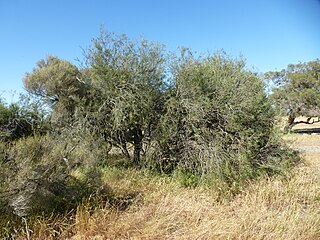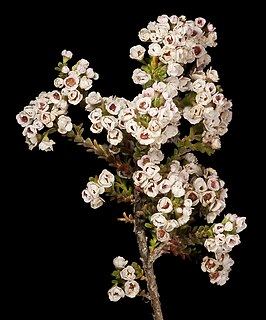| Scholtzia teretifolia | |
|---|---|
| Scientific classification | |
| Kingdom: | Plantae |
| Clade: | Angiosperms |
| Clade: | Eudicots |
| Clade: | Rosids |
| Order: | Myrtales |
| Family: | Myrtaceae |
| Genus: | Scholtzia |
| Species: | S. teretifolia |
| Binomial name | |
| Scholtzia teretifolia | |
Scholtzia teretifolia is a shrub species in the family Myrtaceae that is endemic to Western Australia. [1]

Myrtaceae or the myrtle family is a family of dicotyledonous plants placed within the order Myrtales. Myrtle, pohutukawa, bay rum tree, clove, guava, acca (feijoa), allspice, and eucalyptus are some notable members of this group. All species are woody, contain essential oils, and have flower parts in multiples of four or five. The leaves are evergreen, alternate to mostly opposite, simple, and usually entire. The flowers have a base number of five petals, though in several genera the petals are minute or absent. The stamens are usually very conspicuous, brightly coloured and numerous.
The prostrate and spreading shrub typically grows to a height of 0.1 to 0.2 metres (0.3 to 0.7 ft) and can reach as high as 0.5 m (1.6 ft), it usually has a width of about 1.3 m (4.3 ft). It blooms between October and January producing pink-white flowers. [1]
It is found on sandplains and floodplains along the west coast in the Wheatbelt region of Western Australia between Carnamah and Gingin where it grows in sandy soils. [1]

The Wheatbelt is one of nine regions of Western Australia defined as administrative areas for the state's regional development, and a vernacular term for the area converted to agriculture during colonisation. It partially surrounds the Perth metropolitan area, extending north from Perth to the Mid West region, and east to the Goldfields-Esperance region. It is bordered to the south by the South West and Great Southern regions, and to the west by the Indian Ocean, the Perth metropolitan area, and the Peel region. Altogether, it has an area of 154,862 square kilometres (59,793 sq mi).

Carnamah is a town in the Mid West region of Western Australia, about 307 kilometres (191 mi) north of Perth along the Midlands Road. According to 2006 census, the population of the town is approximately 496.

Gingin is a small town in Western Australia, located on the Brand Highway 67 kilometres (42 mi) north of the Perth city centre. It is the council seat for the Shire of Gingin local government area. Gingin had a population of 743 at the 2011 census, but the shire as a whole had 4,685 people. The town's economy is mostly based on agriculture, although there has been an increasing focus on science with the establishment of the Australian International Gravitational Observatory and Gravity Discovery Centre. There is also a small military airfield, RAAF Gingin, located nearby.








